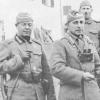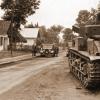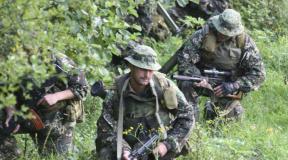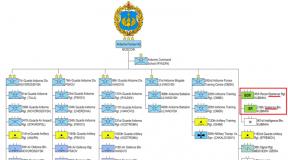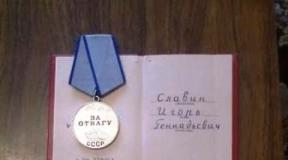Ivan III Vasilievich. Biography. Governing body. Personal life. The era of the reign of Ivan III
1. Sovereign
Moscow Tsar Ivan III Vasilyevich received the nickname “The Great” from historians. Karamzin placed him even higher than Peter I, for Ivan III did a great state work without resorting to violence against the people.
This is generally explained simply. The fact is that we all live in a state, the creator of which is Ivan III. When in 1462 he ascended the Moscow throne, the Moscow principality was still surrounded from everywhere by Russian appanage possessions: Mr. Veliky Novgorod, the princes of Tver, Rostov, Yaroslavl, Ryazan. Ivan Vasilyevich subjugated all these lands either by force or by peaceful agreements. So at the end of his reign, in 1505, Ivan III had only heterodox and foreign neighbors along all the borders of the Moscow state: Swedes, Germans, Lithuania, Tatars.
This circumstance naturally changed the entire policy of Ivan III. Previously, surrounded by appanage rulers like himself, Ivan Vasilyevich was one of many appanage princes, even if only the most powerful. Now, having destroyed these possessions, he turned into a single sovereign of an entire people. In short, if at first his policy was specific, then it became national.
Having become the national sovereign of the entire Russian people, Ivan III adopted a new direction in the foreign relations of Rus'. He threw off the last remnants of dependence on the Golden Horde Khan. He also went on the offensive against Lithuania, from which Moscow had until then only been defending itself. He even laid claim to all those Russian lands that had been owned by Lithuanian princes since the second half of the 13th century. Calling himself “the sovereign of all Rus',” Ivan III meant not only northern, but also southern and western Rus', which he considered his duty to annex to Moscow. In other words, having completed the gathering of Russian appanage principalities, Ivan III proclaimed a policy of gathering the Russian people.
This is the important historical significance of the reign of Ivan III, who can rightfully be called the creator of the national Russian state - Muscovite Rus'.
2. Man
The first Russian Tsar and “Sovereign of All Rus'” Ivan III had a tough temper - he could take off the head of a noble boyar simply for being “clever.” It was with this accusation that in 1499 the sovereign’s closest boyar, Semyon Ryapolovsky, ascended the scaffold. It is not for nothing that the people called Ivan III the Terrible (however, in history this nickname was assigned to the grandson of Ivan III and his full namesake - Ivan IV Vasilyevich. So do not get confused). In the last years of Ivan III's life, his person acquired almost divine greatness in the eyes of his subjects. Women, they say, fainted from one of his angry glances. The courtiers, under pain of disgrace, had to entertain him during his leisure hours. And if, in the midst of this heavy fun, Ivan III happened to doze off in his chair, everyone around him froze - sometimes for whole hours. No one dared to cough or stretch their stiff limbs, lest, God forbid, they wake up the great sovereign.
However, such scenes are explained more by the servility of the courtiers than by the character of Ivan III himself, who by nature was not at all a gloomy despot. Boyar Ivan Nikitich Bersen, remembering his sovereign, later used to say that Ivan III was kind and affectionate to people, and therefore God helped him in everything. In the State Council, Ivan III loved the “meeting”, that is, an objection against himself, and never punished if a person said the right thing. In 1480, during the invasion of Rus' by Khan Akhmat, Ivan III left the army and returned to Moscow. The elderly Rostov Archbishop Vassian, angry with the sovereign for this, began, according to the chronicler, “to speak evil to him,” calling him a runner and a coward. Ivan III with a humble look endured the reproaches of the angry old man.
In his aesthetic tastes, Ivan III was a subtle connoisseur of art, including Western European art. He was the first of the Moscow sovereigns to open the gates of the Kremlin wide to the figures of the Italian Renaissance. Under him, outstanding Italian architects worked in Moscow, creating the very Kremlin palaces and temples that we still admire today. And miniatures appeared in Moscow chronicles, copying fragments of engravings by the great German artist Durer.
In general, Ivan III Vasilyevich was not a bad person.
3. The end of the freedom of the Lord of Veliky Novgorod
In the second half of the 15th century, Novgorod increasingly lost its former independence. Two parties were formed in the city: one stood for an agreement with Lithuania, the other for an agreement with Moscow. Mostly the common people stood for Moscow, and for Lithuania - the boyars, led by mayor Boretsky. At first, the Lithuanian party gained the upper hand in Novgorod. In 1471, Boretsky, on behalf of Novgorod, concluded an alliance treaty with the Lithuanian Grand Duke and at the same time the Polish King Casimir. Casimir promised to defend Novgorod from Moscow, to give the Novgorodians their governor and to observe all the liberties of Novgorod in the old days. In essence, Boretsky’s party committed national treason by surrendering under the patronage of a foreign sovereign, who was also a Catholic.
This is exactly how they looked at this matter in Moscow. Ivan III wrote to Novgorod, urging the Novgorodians to abandon Lithuania and the Catholic king. And when exhortations did not work, the Moscow sovereign began preparations for war. The campaign against Novgorod was given the appearance of a campaign against heretics. Just as Dmitry Donskoy armed himself against the godless Mamai, so, according to the chronicler, the blessed Grand Duke Ivan Vasilyevich went against these apostates from Orthodoxy to Latinism.
Hoping heavily for Lithuanian help, the Novgorod boyars forgot to create their own combat-ready army. This oversight became fatal for them. Having lost two foot troops in battles with the advanced detachments of the Moscow army, Boretsky hastily mounted horses and marched against Ivan III, forty thousand of all sorts of rabble, which, according to the chronicle, had never even been on a horse. Four thousand well-armed and trained Moscow warriors were enough to completely defeat this crowd in the battle on the Sheloni River, killing 12 thousand on the spot.
Posadnik Boretsky was captured and executed as a traitor along with his accomplices. And Ivan III declared his will to the Novgorodians: in order to have the same state in Novgorod as in Moscow, there would not be an eve, there would not be a posadnik, but there would be a sovereign according to Moscow custom.
The Novgorod Republic finally ceased to exist seven years later, in 1478, when, by order of Ivan III, the veche bell was taken to Moscow. However, at least another hundred years passed before the Novgorodians came to terms with the loss of their freedom and began to call their Novgorod land Rus, and themselves Russians, like the rest of the inhabitants of the Moscow state.
4. Autocrat of All Rus'
Ivan Vasilyevich was married twice. His first wife was the sister of his neighbor, the Grand Duke of Tver, Marya Borisovna. After her death in 1467, Ivan III began to look for another wife, further away and more important. At that time, a royal orphan lived in Rome - the niece of the last Byzantine emperor, Sophia Paleologus (let me remind you that in 1453 the Turks conquered Constantinople). Through the mediation of the Pope, Ivan III ordered the Byzantine princess from Italy and married her in 1472.
Finding himself next to such a noble wife, Ivan III began to disdain the cramped and ugly Kremlin environment in which his ancestors lived. Following the princess, craftsmen were sent from Italy who built Ivan a new Assumption Cathedral, the Chamber of Facets and a stone palace on the site of the previous wooden mansion. At the same time, a new, strict and solemn ceremony, modeled on the Byzantine one, was introduced at the Moscow court.
Feeling like the heir to the Byzantine state, Ivan III began to write his title in a new way, again in the manner of the Greek kings: “John, by the grace of God, sovereign of all Rus' and Grand Duke of Vladimir, Moscow, Novgorod, Pskov, Tver, Perm, Ugra and other lands."
Sofia Paleolog was an unusually plump woman. At the same time, she had an extremely subtle and flexible mind. She was credited with great influence on Ivan III. They even said that it was she who prompted Ivan to throw off the Tatar yoke, because she was ashamed to be the wife of a Horde tributary.
5. Overthrow of the Horde yoke
This happened without loud victories, somehow casually, almost by itself. However, first things first.
At the beginning of the reign of Ivan III, there was not one, but three independent Tatar hordes along the borders of Russia. Exhausted by strife, the Golden Horde lived out its life. In the 1420s-30s, Crimea and Kazan broke away from it, where special khanates arose with their own dynasties. Taking advantage of disagreements among the Tatar khans, Ivan III gradually subjugated Kazan to his influence: the Kazan khan recognized himself as a vassal of the Moscow sovereign. Ivan III had a strong friendship with the Crimean Khan, since both of them had a common enemy - the Golden Horde, against which they were friends. As for the Golden Horde itself, Ivan III stopped all relations with it: he did not give tribute, did not go to bow to the khan, and once even threw the khan’s letter to the ground and trampled on it.
The weak Golden Horde Khan Akhmat tried to act against Moscow in alliance with Lithuania. In 1480, he led his army to the Ugra River, to the border between Moscow and Lithuania. But Lithuania already had his mouth full of troubles. Akhmat did not receive Lithuanian help, but the Moscow prince met him with a strong army. A months-long “standing on the Ugra” began, as the opponents did not dare to engage in open battle. Ivan III ordered the capital to be prepared for a siege, and he himself came from the Ugra to Moscow, fearing not so much the Tatars as his brothers - they were in a quarrel with him and instilled in Ivan III the suspicion that they would betray him at the decisive moment. The prince's prudence and slowness seemed cowardice to Muscovites. The clergy implored Ivan III not to be a “runner”, but to bravely stand against the enemy.
But a decisive battle never happened. Having stood on the Ugra from summer until November, Akhmat went home with the onset of frost. Soon he was killed in another strife, his sons died in the fight against the Crimean Khanate, and in 1502 the Golden Horde ceased to exist.
Thus fell the Horde yoke, which had weighed on Russia for two and a half centuries. But the troubles from the Tatars for Rus' did not stop there. The Crimeans, Kazanians, as well as smaller Tatar hordes, constantly attacked the Russian borderlands, burned, destroyed homes and property, and took people and livestock with them. The Russian people had to fight this incessant Tatar robbery for no less than another three centuries.
6. Sovereign flight of the Russian eagle
It was not by chance that this strange bird appeared in Russian state symbols. Since ancient times, it has decorated the coats of arms and banners of many great powers, including the Roman Empire and Byzantium. In 1433, the double-headed eagle was also established in the coat of arms of the Habsburgs, the ruling dynasty of the Holy Roman Empire, which considered themselves the successors to the power of the Roman Caesars. However, Ivan III, who was married to the niece of the last Byzantine emperor, Sophia Paleologus, also claimed this honorary relationship, and after the overthrow of the Horde yoke, he accepted the title of “Autocrat of All Rus'.” It was then that a new genealogy of Moscow sovereigns appeared in Rus', allegedly descending from Prus, the legendary brother of Emperor Octavian Augustus.
In the mid-80s of the 15th century, Emperor Frederick III of Habsburg invited Ivan III to become a vassal of the Holy Roman Empire, promising in return to give him a royal title, but received a proud refusal: “We are, by the grace of God, sovereigns on our land from the beginning, from our first ancestors, and for the kingdom, just as we didn’t want it from anyone before, we don’t want it now.” To emphasize his equal honor to the emperor, Ivan III adopted a new state symbol of the Moscow State - the double-headed eagle. The marriage of the Moscow sovereign with Sophia Paleologus made it possible to draw a line of succession for the new coat of arms, independent of the West - not from the “first” Rome, but from the “second” Rome - Orthodox Constantinople.
The oldest image of a double-headed eagle in Russia is stamped on the wax seal of Ivan III, attached to the charter of 1497. Since then, the sovereign eagle has symbolized the state and spiritual sovereignty of Russia.
7. Western influences
Some historians also call the first sovereign of all Rus', Ivan III Vasilyevich, the first Russian Westernizer, drawing a parallel between him and Peter I.
Indeed, under Ivan III, Russia moved forward by leaps and bounds. The Mongol-Tatar yoke was thrown off, specific fragmentation was destroyed. The high status of the Moscow sovereign was confirmed by the adoption of the title of Sovereign of All Rus' and the prestigious marriage to the Byzantine princess Sophia Paleologus. In a word, Russia has become a full-fledged sovereign state. But national self-affirmation had nothing to do with national isolation. On the contrary, it was Ivan III, more than anyone else, who contributed to the revitalization and strengthening of Moscow’s ties with the West, with Italy in particular.
Ivan III kept the visiting Italians with him in the position of court “masters,” entrusting them with the construction of fortresses, churches and chambers, casting cannons, and minting coins. The names of these people are preserved in the chronicle: Ivan Fryazin, Mark Fryazin, Antony Fryazin, etc. These are not namesakes or relatives. It’s just that Italian craftsmen in Moscow were called by the common name “fryazin” (from the word “fryag”, that is, “franc”). Particularly famous among them was the outstanding Italian architect Aristotle Fioravanti, who built the famous Assumption Cathedral and the Chamber of Facets in the Moscow Kremlin (so named due to its decoration in the Italian style - facets). In general, under Ivan III, through the efforts of the Italians, the Kremlin was rebuilt and decorated anew. Back in 1475, a foreigner who visited Moscow wrote about the Kremlin that “all the buildings in it, not excluding the fortress itself, are wooden.” But twenty years later, foreign travelers began to call the Moscow Kremlin a “castle” in European style, due to the abundance of stone buildings in it. Thus, through the efforts of Ivan III, the Renaissance flourished on Russian soil.
In addition to the masters, ambassadors from Western European sovereigns often appeared in Moscow. And, as was evident from the example of Emperor Frederick, the first Russian Westernizer knew how to talk with Europe on equal terms.
8. Heresy of the “Judaizers”
In the 15th century, flakes of human ash flew over Western Europe. This was the time of the most severe persecution of witches and heretics. According to the most conservative estimates, the number of victims of the Inquisition is in the tens of thousands. In Castile alone, the Grand Inquisitor Torquemada burned about 10 thousand people. Unfortunately, Russia also did not escape the general craze. Under Ivan III, fire performances were also staged here, although they were not so large-scale.
The heresy of the “Judaizers” was brought into Russia from outside. In 1470, the Novgorodians, straining their last efforts to defend their independence from Moscow, invited the Orthodox Kyiv prince Alexander Mikhailovich, in agreement with the Polish king. In the prince's retinue, the Jewish physician Skhariya and two more of his fellow tribesmen, well-read in theology, arrived in Novgorod. It all started with them. In disputes with Russian priests, visiting supporters of the Torah (that is, the Old Testament) put forward a simple syllogism: they appealed to the words of Christ that he “came not to destroy the law, but to fulfill it.” From this followed the conclusion about the primacy of the Old Testament over the New, of Judaism over Christianity. The wretched thought of the Novgorod priests went crazy with this syllogism. Three learned Jews stayed in Novgorod for only a year, but this was enough for their conversations to penetrate deeply into the souls of the Novgorod priests. They began to profess a strange mixture of Judaism and Christianity, for which they received their name “Judaizers.”
The Judaizer sect was well kept secret. Therefore, the Novgorod Archbishop Gennady did not immediately succeed in bringing the heretics to light. In the end, one of the “Judaizers,” priest Naum, broke down and repented, and reported on the doctrine and cult of his co-religionists. A church investigation began. On the issue of punishing those guilty of heresy, opinions in the Russian Church were divided. Part of the clergy called for action against heretics with only spiritual exhortation, without physical punishment. But those who stood for physical execution won. And it was the foreign example that inspired them. In 1486, an ambassador of the Austrian emperor passed through Novgorod. He told Archbishop Gennady about the Spanish Inquisition and received great sympathy from him.
Gennady gave the heretics special torture in the style of the Spanish Inquisition. Gennady’s people put the arrested people on horses backwards, and they put birch bark caps with washcloths on their heads and with the inscription: “This is Satan’s army.” When the cavalcade arrived in the city square, the jester's helmets were set on fire on the heads of the heretics. Moreover, some of them were also publicly beaten, and several people were burned alive.
This action became the first inquisition experience of the Russian Orthodox Church. To the credit of the Russian clergy, it should be noted that they quite quickly managed to overcome this shameful temptation. So, unlike the Catholic Inquisition, our domestic church tribunals have not become a constant phenomenon, and their victims are counted in just a few.
9. Russia under Ivan III
The first detailed notes by foreigners about Russia, or Muscovy, to use their terminology, date back to the reign of Ivan III Vasilyevich and his son Vasily III.
The Venetian Josaphat Barbaro, a merchant, was struck first of all by the well-being of the Russian people. Noting the wealth of the Russian cities he saw, he wrote that all of Rus' in general was “abundant in bread, meat, honey and other useful things.”
Another Italian, Ambrogio Cantarini, especially emphasized the importance of Moscow as an international trade center: “Many merchants from Germany and Poland gather in the city throughout the winter.” He also left in his notes an interesting verbal portrait of Ivan III. According to him, the first sovereign of all Rus' was “tall, but thin, and generally a very handsome man.” As a rule, Cantarini continues, the rest of the Russians are “very beautiful, both men and women.” As a devout Catholic, Cantarini did not fail to note the unfavorable opinion of Muscovites about Italians: “They believe that we are all lost people,” that is, heretics.
Another Italian traveler Alberto Campenze composed an interesting note “On the Affairs of Muscovy” for Pope Clement VII. He mentions the well-organized border service of the Muscovites and the ban on the sale of wine and beer (except on holidays). The morality of Muscovites, according to him, is beyond praise. “They consider it a terrible, vile crime to deceive each other,” writes Campenze. - Adultery, violence and public debauchery are also very rare. Unnatural vices are completely unknown, and perjury and blasphemy are completely unheard of.”
As we see, the vices of the West were not in fashion in Moscow at the end of the 15th - beginning of the 16th centuries. However, general progress very soon affected this side of Moscow life.
10. End of reign
The end of the reign of Ivan III was overshadowed by family and court intrigues. After the death of his son from his first marriage, Ivan the Young, the sovereign decided to transfer all power to his son - his grandson Demetrius, for which in 1498 he performed the first royal wedding ceremony in Russian history, during which barmas and the Monomakh's hat were placed on Demetrius .
But then supporters of another heir, Vasily, the son from the sovereign’s second marriage to Sophia Paleologus, gained the upper hand. In 1502, Ivan III “put disgrace” on Demetrius and his mother, Grand Duchess Elena, and Vasily, on the contrary, was granted a great reign.
All that remained was to find a worthy wife for the new heir.
Ivan III considered the crown and barmas of Monomakh to be equal in dignity to royal and even imperial crowns. Having himself married for the second time to the niece of the last Byzantine emperor, Princess Sophia Paleologus, he also looked for brides of royal origin for his children.
When the time had come for his eldest son from his second marriage, Vasily, to get married, Ivan Vasilyevich, without deviating from his rules, began wedding negotiations abroad. However, wherever he turned, he had to listen to a refusal that was unusual for his ears. The daughter of Ivan III, Elena, married to the Polish king, in a letter to her father explained the failure by the fact that in the West they do not like the Greek faith, considering the Orthodox to be non-Christians.
There was nothing to do, I had to intermarry with one of my slaves. The sovereign's heart, which suffered from such humiliation, was consoled by clever courtiers who pointed to examples from Byzantine history when emperors chose their wives from girls gathered to court from all over the state.
Ivan Vasilyevich perked up. The essence of the matter, of course, did not change, but the sovereign's honor was saved! In this way, it happened that at the end of the summer of 1505, Moscow found itself chock-full of beauties, trembling from the proximity of extraordinary happiness - the grand ducal crown. Not a single modern beauty contest can compare in scale to those shows. There were neither more nor fewer girls - one and a half thousand! The midwives meticulously examined this lovely herd, and then, deemed fit to continue the sovereign's family, they appeared before the no less discerning gaze of the groom. Vasily took a liking to the girl Solomonia, the daughter of the noble Moscow boyar Yuri Konstantinovich Saburov. On September 4 of the same year the wedding took place. Since then, this, so to speak, herd method of marriage became a custom among Moscow sovereigns and lasted for almost two hundred years, until the reign of Peter I.
The wedding celebrations became the last joyful event in the life of Ivan Vasilyevich. A month and a half later he died. Vasily III unhinderedly took the paternal throne.
The eldest son of Vasily II Vasilyevich the Dark took part in the internecine war of 1452. Due to the blinding of his father by Vasily Kosym, Ivan III became involved early in the process of governing the state (from 1456). Grand Duke of Moscow since 1462. Continuing the policy of expanding the territories of the Moscow principality, Ivan III, with fire and sword, and sometimes through diplomatic negotiations, subjugated the principalities: Yaroslavl (1463), Rostov (1474), Tver (1485), Vyatka land (1489), etc. In 1471 made a campaign against Novgorod and defeated opponents in the Battle of Shelon, and then in 1478 he finally destroyed the independence of the Novgorod Republic, subordinating it to Moscow. During his reign, Kazan also became loyal to the Moscow prince, which was an important achievement of his foreign policy.
Ivan III, having assumed his great reign, for the first time since Batu’s invasion, refused to go to the Horde to receive a label. In an attempt to once again subjugate Rus', which had not paid tribute since 1476, Khan Akhmat in 1480 sent a large army to the Moscow principality. At this moment, the forces of Moscow were weakened by the war with the Livonian Order and the feudal rebellion of the younger brothers of the Grand Duke. In addition, Akhmat enlisted the support of the Polish-Lithuanian king Casimir. However, the Polish forces were neutralized thanks to the peace treaty of Ivan III with the Crimean Khan Mengli-Girey. After Akhmat’s attempt to cross the river. Ugra in October 1480, accompanied by a 4-day battle, began the “standing on the Ugra”. The "Ugorshchina", during which the forces of the parties were located on different banks of the Oka tributary, ended on November 9-11, 1480 with the flight of the enemy. Thus, victory on the river. Ugra marked the end of the 240-year Mongol-Tatar yoke.
No less important was the success in the wars with the Grand Duchy of Lithuania (1487-1494; 1500-1503), thanks to which many western lands went to Rus'.
As a result of victories over external enemies, Ivan III was able to destroy most of the fiefs and thereby greatly strengthen the central power and the role of Moscow.
Moscow, as the capital of a new large state, was greatly transformed during the reign of Ivan III: a new Assumption Cathedral was erected and a new Archangel Cathedral was founded, construction of a new Kremlin, the Faceted Chamber, and the Annunciation Cathedral began. Italian foreign craftsmen played an important role in the construction of the renewed capital. For example, Aleviz the New, Aristotle Fioravanti.
The new large state, which became the Principality of Moscow under Ivan III, needed a new ideology. Moscow as a new center of Christianity was presented in the “Exposition of Paschal” by Metropolitan Zosima (1492). The monk Philotheus proposed the formula “Moscow is the third Rome” (after the death of Ivan III). The basis of this theory was the fact that the Moscow state (after the capture of Constantinople by the Turks in 1453) remained the only independent Orthodox state in the world, and the sovereign who headed it was the only protector of all Orthodox Christians on earth. Ivan III also had formal reasons to consider himself the heir of Byzantium, since he was married for the second time to the niece of the last Byzantine emperor, Sophia (Zoe) Paleologus.
The strengthening of central power made it necessary to create new government bodies - orders. At the same time, the legislative code of the united Rus' appeared - the Code of Laws of 1497, which, unfortunately, has come down to us in only one copy. In order to enlist the support of service people, the Grand Duke guaranteed them economic well-being by regulating the transfer of peasants from one owner to another: peasants received the right to transfer only once a year - a week before the autumn St. George's Day (November 26) and a week after.
Modern historians also associate the reign of Ivan III with the beginning of the process of Europeanization, which ensured the defense capability and economic prosperity of the country.
The grateful descendants of their ruler Ivan III Vasilyevich called him “the Collector of Russian Lands” and Ivan the Great. And he extolled this statesman even higher than. He, the Grand Duke of Moscow, ruled the country from 1462 to 1505, managing to increase the territory of the state from 24 thousand square kilometers to 64 thousand. But the main thing is that he finally managed to free Rus' from the obligation to pay a huge quitrent to the Golden Horde every year.
Ivan the Third was born in January 1440. The boy became the eldest son of the Great Moscow Prince Vasily II Vasilyevich and Maria Yaroslavna, granddaughter of Prince Vladimir the Brave. When Ivan was 5 years old, his father was captured by the Tatars. In the Principality of Moscow, the eldest of the descendants, the prince, was immediately placed on the throne. For his release, Vasily II was forced to promise the Tatars a ransom, after which the prince was released. Arriving in Moscow, Ivan’s father again took the throne, and Shemyaka went to Uglich.
Many contemporaries were dissatisfied with the actions of the prince, who only worsened the situation of the people by increasing the tribute to the Horde. Dmitry Yuryevich became the organizer of a conspiracy against the Grand Duke, together with his comrades-in-arms, he took Vasily II prisoner and blinded him. Those close to Vasily II and his children managed to hide in Murom. But soon the freed prince, who by that time had received the nickname Dark due to his blindness, went to Tver. There he enlisted the support of Grand Duke Boris Tverskoy, betrothing six-year-old Ivan to his daughter Maria Borisovna.
Soon Vasily managed to restore power in Moscow, and after the death of Shemyaka, civil strife finally ceased. Having married his bride in 1452, Ivan became his father's co-ruler. The city of Pereslavl-Zalessky came under his control, and at the age of 15, Ivan had already made his first campaign against the Tatars. By the age of 20, the young prince led the army of the Moscow principality.
At the age of 22, Ivan had to take over the reign on his own: Vasily II died.
Governing body
After the death of his father, Ivan the Third inherited the largest and most significant inheritance, which included part of Moscow and the largest cities: Kolomna, Vladimir, Pereyaslavl, Kostroma, Ustyug, Suzdal, Nizhny Novgorod. Ivan's brothers Andrey Bolshoy, Andrey Menshoy and Boris were given control over Uglich, Vologda and Volokolamsk.
Ivan III, as his father bequeathed, continued the policy of collecting. He consolidated the Russian state by all possible means: sometimes by diplomacy and persuasion, and sometimes by force. In 1463, Ivan III managed to annex the Yaroslavl principality, and in 1474 the state expanded due to the lands of Rostov.

But that was just the beginning. Rus' continued to expand, acquiring vast expanses of Novgorod lands. Then Tver surrendered to the mercy of the winner, and behind it Vyatka and Pskov gradually came into the possession of Ivan the Great.
The Grand Duke managed to win two wars with Lithuania, taking possession of a large part of the Smolensk and Chernigov principalities. Tribute to Ivan III was paid by the Livonian Order.
A significant event during the reign of Ivan III was the annexation of Novgorod. The Grand Duchy of Moscow tried to annex Novgorod since the time of Ivan Kalita, but only succeeded in imposing tribute on the city. The Novgorodians sought to maintain independence from Moscow and even sought support from the Principality of Lithuania. The only thing that kept them from taking the final step was that Orthodoxy was in danger in this case.

However, with the installation of the Lithuanian protege, Prince Mikhail Olelkovich, in 1470 Novgorod signed an agreement with King Casemir. Having learned about this, Ivan III sent ambassadors to the northern city, and after disobedience, a year later he started a war. During the Battle of Shelon, the Novgorodians were defeated, but no help came from Lithuania. As a result of negotiations, Novgorod was declared the patrimony of the Moscow prince.
Six years later, Ivan III launched another campaign against Novgorod, after the city’s boyars refused to recognize him as sovereign. For two years, the Grand Duke led a grueling siege for the Novgorodians, ultimately finally subjugating the city. In 1480, the resettlement of Novgorodians began to the lands of the Moscow Principality, and Moscow boyars and merchants to Novgorod.
But the main thing is that from 1480 the Grand Duke of Moscow stopped paying tribute to the Horde. Rus' finally sighed from the 250-year yoke. It is noteworthy that liberation was achieved without bloodshed. For a whole summer, the troops of Ivan the Great and Khan Akhmat stood against each other. They were separated only by the Ugra River (the famous standing on the Ugra). But the battle never took place - the Horde left with nothing. In the game of nerves, the army of the Russian prince won.

And during the reign of Ivan III, the current Moscow Kremlin appeared, built of brick on the site of an old wooden building. A set of state laws was written and adopted - the Code of Laws, which cemented the young power. The rudiments of diplomacy and a local landowning system, advanced for its time, also appeared. Serfdom began to take shape. Peasants, who previously moved from one owner to another freely, were now limited to the term of St. George's Day. The peasants were allocated a certain time of year for the transition - the week before and after the autumn holiday.
Thanks to Ivan the Third, the Grand Duchy of Moscow turned into a strong state, which became known in Europe. And Ivan the Great himself turned out to be the first Russian ruler to call himself “the sovereign of all Rus'.” Historians claim that today’s Russia basically has the foundation that Ivan III Vasilyevich laid with his activities. Even the double-headed eagle migrated to the coat of arms of the state after the reign of the Grand Duke of Moscow. Another symbol of the Moscow principality borrowed from Byzantium was the image of St. George the Victorious slaying a serpent with a spear.

They say that the doctrine of “Moscow is the Third Rome” originated during the reign of Ivan Vasilyevich. Which is not surprising, because under him the size of the state increased almost 3 times.
Personal life of Ivan III
The first wife of Ivan the Great was Princess Maria of Tverskaya. But she died after giving birth to her husband's only son.
The personal life of Ivan III changed 3 years after the death of his wife. The marriage to the enlightened Greek princess, niece and goddaughter of the last emperor of Byzantium, Zoe Paleologus, turned out to be fateful both for the sovereign himself and for all of Rus'. Baptized in Orthodoxy, she brought a lot of new and useful things into the archaic life of the state.

Etiquette appeared at court. Sofya Fominichna Paleolog insisted on rebuilding the capital, “dispatching” famous Roman architects from Europe. But the main thing is that it was she who begged her husband to decide to refuse to pay tribute to the Golden Horde, because the boyars were extremely afraid of such a radical step. Supported by his faithful wife, the sovereign tore up another khan's letter, which the Tatar ambassadors brought him.
Probably, Ivan and Sophia really loved each other. The husband listened to the wise advice of his enlightened wife, although his boyars, who previously had undivided influence over the prince, did not like this. In this marriage, which became the first dynastic, numerous offspring appeared - 5 sons and 4 daughters. State power passed to one of the sons.
Death of Ivan III
Ivan III outlived his beloved wife by only 2 years. He died on October 27, 1505. The Grand Duke was buried in the Archangel Cathedral.

Later, in 1929, the relics of both wives of Ivan the Great - Maria Borisovna and Sofia Paleologue - were transferred to the basement chamber of this temple.
Memory
The memory of Ivan III is immortalized in a number of sculptural monuments, which are located in Kaluga, Naryan-Mar, Moscow, and in Veliky Novgorod on the “Millennium of Russia” monument. Several documentaries are devoted to the biography of the Grand Duke, including those from the “Rulers of Rus'” series. The love story of Ivan Vasilyevich and Sofia Paleolog formed the basis of the plot of the Russian series by Alexei Andrianov, where the main roles were played by and.
Announcement: perishing from the invasion of the Turks, Byzantium handed over the double-headed eagle to Rus' as a symbol of the harmony of heavenly and earthly power.
By the 15th century the conditions for centralization The Russians were created. Under Grand Duke Ivan III ( 1462 - 1505 ) the right to become the center of Christianity in the world was accepted from Byzantium. Almost all the principalities submitted to Moscow. IN 1478 Novgorod land also joined. Having strengthened, Ivan III stopped paying tribute Orde. In front of the Horde ambassadors, he tore up the Khan's letter. At that time, Khan Akhmat ruled the Horde. To punish the offender, he moved a huge army to Rus'.
Russian troops took up a position along the river bank Ugrians. On the other bank were the Horde. Khan Akhmat expected the king to attack the Russians from the rear Kazimir. But the cunning Ivan III persuaded the Crimean Khan to attack the lands of Casimir, and thwarted the enemy operation. The Mongols stood waiting for about 5 months. One morning, the Russians saw dying fires on the other side of the Ugra. The victory turned out to be bloodless. IN 1480 year, the yoke of the Mongol-Tatar khans was overthrown forever.
IN 1485 year Tver entered into a single state. IN 1497 was published "Code of Law"- a set of laws for a united Rus'. It is established that peasants will leave their owners only during 2 weeks of November if they pay a special tax. Any peasant could become free. This was done a week before “St. George’s Day” and a week after it.
Were created orders- a prototype of ministries. Created Boyar Duma - advisory body of power under the Grand Duke. The principle was established - the sovereign indicated, the boyars sentenced.
There was localism- places and positions were distributed according to nobility. Feeding- a system when governors collected taxes from the people, took part for themselves (to feed), and gave part to the state. Their nobles The prince placed those who served faithfully on the lands. They began to call landowners. The prince took away part of the lands from the church ( secularization).
Thus, the power of the Grand Duke increased. This brought great benefits to the country. Its international authority has grown. Muscovy began to be called Russia. Ivan III was an energetic, wise man. I managed to do so much without the Internet and mobile phones.
The main goal in the life of Ivan III was the creation of a unified Russian state under the supreme authority of one ruler, a state strong enough to exist in a hostile world. It was towards achieving this goal that all his actions were aimed both within the country and abroad. We, therefore, cannot draw a sharp line between his national and foreign policies. When he became the Grand Duke of Moscow, Great Russia was still fragmented, and the traditions of the Kyiv period were alive. Not only the rulers of the local great principalities, such as Tver, Ryazan or Novgorod land, but even the younger Moscow princes themselves did not want to recognize the supreme power of Ivan III. Commercial interests played an important role in the diplomacy of Ivan III (both in the East and in the West). Kazan and Crimea were significant centers of international trade and annually attracted a large number of Russian merchants. The Moscow government made significant efforts to support them and keep trade routes open. The khans of the Golden Horde remained able to block the road from Moscow to Crimea along the Don whenever they wished, which they actually did quite often. Moscow merchants then had to get to Crimea by the western route, through the territory of the Middle Dnieper, which was under the control of Lithuania. As a matter of fact, control over these routes played a prominent role in Moscow’s clashes with the Golden Horde and Lithuania. In the struggle between Roman Catholicism and Greek Orthodoxy, Ivan III acted as a defender of Orthodoxy and a determined opponent of Roman Catholicism. As we saw above, thanks to this position he was able to undermine the unity of the Novgorodians. She also attracted the sympathy of some Western Russian princes, which served his interests in clashes with Lithuania.
Already under the son of Ivan III, Vasily III (1505–1533), in 1510 Pskov became part of Russia, and Ryazan was the last in 1521. In 1480, the Mongol-Tatar yoke was lifted and Russia became independent.
United Russian State: 1) central power in the country was exercised by the Grand Duke and together with him the Boyar Duma (an advisory body under the ruler). At the same time as the boyar elite, the service nobility also came into force. It often served as a support for the Grand Duke during his struggle with the noble boyars. For their service, the nobles acquired estates that could not be inherited. At the beginning of the 16th century. orders were formed - institutions that performed the functions of managing military, judicial and financial affairs. The order was headed by a boyar or clerk - a major government official. Over time, the tasks of public administration became more complex, and the number of orders increased. The design of the order system made it possible to strengthen the centralized management of the country;
2) the country was divided into districts (which were the former appanage principalities) headed by a governor. The counties, in turn, were divided into volosts headed by volostels;
3) governors and volostels received lands for feeding, from which they collected part of the taxes in their favor. Appointment to positions took place on the basis of localism (this was the name of the order in which preference during appointment to the civil service was given to people of high birth, nobles, and not those distinguished by knowledge, intelligence and appropriate abilities). Later the feedings were cancelled. Local administration was in the hands of provincial elders (guba - district), who were elected from local nobles, as well as zemstvo elders, who were chosen from among the black-sown population, and city clerks - from city residents;
4) in the 16th century. An apparatus of state power emerged in the form of an estate-representative monarchy. Activities that were aimed at strengthening the grand ducal power were very actively carried out by Ivan IV. At the initial stage of his reign, Ivan IV still put up with the existence of the Elected Rada - the Near Duma of the sovereign, which included his closest like-minded people. The elected Rada was not an official government body, but in fact governed the Russian state on behalf of the Tsar.
In 1549, the first Zemsky Sobor was convened, which was an advisory body, a meeting of class representatives from boyars, nobles, clergy, merchants, townspeople and black-growing peasants. By decisions of the Zemsky Sobor, measures were taken that significantly expanded the rights of the nobles and limited the rights of large feudal lords - boyars, who could form opposition to the tsar. Zemsky Sobors were not permanent bodies of state power; they met irregularly.
Almost half a century of the reign of Ivan III, later nicknamed the Great, became the era of Moscow’s final victory in the struggle for the unification of the lands of northeastern Rus' and the elimination of the Mongol-Tatar yoke. Ivan the Great abolished the statehood of Tver and Novgorod and conquered significant territories west of Moscow from the Grand Duchy of Lithuania. He refused to pay tribute to the Horde, and in 1480, after standing on the Ugra, tributary relations with the Horde were completely broken. By the time of the death of Ivan III, the process of collecting lands was almost completed: only two principalities remained formally independent from Moscow - Pskov and Ryazan, but they also actually depended on Ivan III, and during his reign, his son Vasily III was actually included in the Moscow principality.
Grand Duke Ivan III strengthened not only the foreign policy positions of his state, but also its legal and financial system. The creation of the Code of Laws and the implementation of monetary reform streamlined the social life of the Grand Duchy of Moscow.
Years of reign (from 1462 to 1505);
He was the son of Vasily II Vasilyevich the Dark;
The Novgorod land was annexed to the Moscow state during the reign of Ivan III;
In 1478, one of the oldest cities in Rus' was forcibly annexed to the Grand Duchy. This was the city of Novgorod the Great.
wars of the Moscow State with the Grand Duchy of Lithuania - 1487-1494;
Vasily III - 1507-1508;
1512-1522 - wars of the Moscow state with the Grand Duchy of Lithuania;
Rus' finally stopped paying tribute to the Golden Horde during the reign of Prince Ivan III;
1480 - standing on the Ugra River;
The reign of Ivan III is characterized:
- a qualitatively new stage in the development of statehood (centralization):
- entry of Rus' into the number of European states.
Russia has not yet played a definite role in world life; it has not yet truly entered the life of European humanity. Great Russia still remained a secluded province in world and European life; its spiritual life was isolated and closed.
This period of Russian history can be characterized as pre-Petrine time.
A) 1478 - annexation of Novgorod. | Battle of the Sheloni River - 1471. The Novgorodians paid the ransom and recognized the power of Ivan III. 1475 – entry of Ivan 3 into Novgorod to protect the offended. After the first campaign against Novgorod, Ivan III secured the right of the supreme court in the Novgorod lands. 1478 - capture of Novgorod. The veche bell was taken to Moscow Confiscation of boyar lands. Ivan III secured his |
B) 1485 — defeat of Tver | 1485 - victory in the war. Began to be called “Sovereign of All Rus'” |
The final entry of the Rostov principality into the Moscow state occurred through a voluntary agreement |
|
B) capture of Ryazan | By 1521 - final loss of independence in 1510 |
The annexation of Pskov to the Moscow state during the formation of a unified Russian state |
Political wisdom of Ivan III | Weakening of the Golden Horde |
He pursued a policy increasingly independent of the Horde. | Search for allies. |
1476 - termination of payment of tribute. | Akhmat managed to gather all the military forces of the former Golden Horde. But they showed their inability to conduct decisive military operations. |
Standing on the Ugra River, Russian and Mongolian troops: a) the Russian and Mongolian troops had a numerical balance; b) the Mongol-Tatars made unsuccessful attempts to ford the river c) hired Crimean infantry acted on the side of the Russians d) Russian troops had firearms at their disposal |
|
About gradual formation of a centralized state in Russia testifies:
monetary reform of Elena Glinskaya
division of Russian lands into volosts
In the Moscow state of the XV-XVI centuries. an estate was a land holding granted on the condition of service in the fight against the feudal elite: the Russian clergy, who sought to play a key role in politics, the sovereign elevated a group of young Novgorod priests led by Fyodor Kuritsyn. As it turned out, many of the views of these grand ducal protégés were heretical (the heresy of the “Judaizers”)
Signs of a centralized state:
1. highest state body - Boyar Duma (legislative)
2. single law - Sudebnik
3. multi-stage system of service people
4. a unified management system is being formed
The first order is from the middle of the 15th century. The Treasury stands out (it managed the palace economy).
The attributes of royal power took shape, and the double-headed Byzantine eagle became the coat of arms.
The role of the Zemsky Sobor | Code of Law | The role of the Boyar Duma |
In Moscow Rus' XVI - XVII centuries. the body of class representation, which ensured the connection between the center and the localities, was called the “Zemsky Sobor” | 1497 – uniform norms of criminal liability and procedures for conducting investigations and trials. St. George's Day (Article 57) - restriction of the right of peasants to leave their feudal lord. St. George's Day and the elderly. | Since the end of the 15th century, the highest state government has been established. body of a centralized state. Composition: boyars of the Moscow prince + former appanage princes. Legislative body |
The attributes of royal power were formed: the double-headed eagle and the Monomakh Cap. | ||
Code of Law of Ivan III: a) this is the first set of laws of a single state b) laid the foundation for the formation of serfdom c) established procedural norms in the legal sphere (Zuev established the procedure for conducting investigations and trials). The judge has not yet determined the competence of officials, because The control system was still just taking shape. |






